Related Research Articles

Menua, also rendered Meinua or Minua, was the fifth known king of Urartu from c. 810 BC to approximately 786 BC. In Armenian, Menua is rendered as Menua. The name Menua may be connected etymologically to the Ancient Greek names Minos and Minyas.

Argishti I, was the sixth known king of Urartu, reigning from 786 BC to 764 BC. He founded the citadel of Erebuni in 782 BC, which is the present capital of Armenia, Yerevan. Alternate transliterations of the name include Argishtis, Argisti, Argišti, and Argishtish. Although the name is usually rendered as Argišti, some scholars argue that Argisti is the most likely pronunciation. This is due to the belief that the Urartians used the cuneiform symbol š to voice an s-sound, as opposed to representing the digraph sh.
Rusa I was a King of Urartu. He succeeded his father, king Sarduri II. His name is sometimes transliterated as Rusas or Rusha. He was known to Assyrians as Ursa and possibly Urzana. His birth name may have been Uedipri.

Muṣaṣir, in Urartian Ardini was an ancient city of Urartu, attested in Assyrian sources of the 9th and 8th centuries BC.
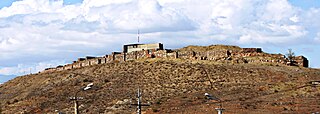
Erebuni Fortress is an Urartian fortified city, located in Yerevan, Armenia. It is 1,017 metres (3,337 ft) above sea level. It was one of several fortresses built along the northern Urartian border and was one of the most important political, economic and cultural centers of the vast kingdom. The name Yerevan itself is derived from Erebuni.
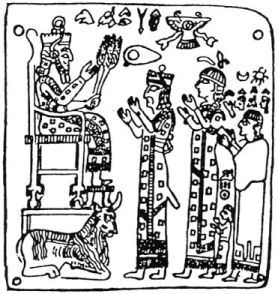
Ishpuini was king of Urartu. He succeeded his father, Sarduri I, who moved the capital to Tushpa (Van). Ishpuini conquered the Mannaean city of Musasir, which was then made the religious center of the empire. The main temple for the war god Haldi was in Musasir. Ishpuini's kingdom was then attacked by the forces of the Assyrian King Shamshi-Adad V. Ishpuini fought and defeated Shamshi-Adad. Ishpuini was so confident in his power that he began using names meaning everlasting glory, including, "King of the land of Nairi", "Glorious King", and "King of the Universe".
Sarduri I, also known as Sarduris, Sedur, and Asiduri, was a king of Urartu in Armenian Highlands. He was known as Ishtarduri to the Assyrians.

Argishti II was king of Urartu from 714 BC to 680 BC. He succeeded his father, King Rusa I. During the Urartu-Assyria War, Argishti was responsible for orchestrating major Urartian counter-offensives against the invading Assyrians. His forces drove the Assyrians back across the pre-war border and deep into the Assyrian heartlands, reconquering major towns and cities around Lake Urmia, including Mushashir, Ushnu, and Tepe, and conquering the territory as far south as the city of Nimrud on the Tigris River. These victories forced the Assyrians to accept a lengthy peace and cede large tracts of territory north of the Tigris. The remainder of Argishti's lengthy reign was characterized by a "Golden Age", a period of lengthy peace and economic prosperity, which carried into the reigns of Argishti's two successors, his son Rusa II and his grandson Sarduri III.
Lutipri was the father of the Urartian king Sarduri I.
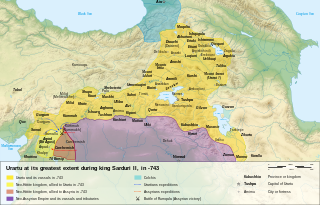
Sarduri II was a King of Urartu, succeeding his father Argishti I to the throne. The Urartian Kingdom was at its peak during his reign, campaigning successfully against several neighbouring powers, including Assyria.
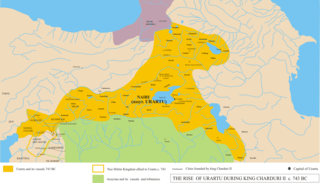
The Urartu–Assyria War was a conflict between the Kingdom of Urartu and the Neo-Assyrian Empire. The war began around 714 BC, with the invasion of Urartu by the Assyrian King Sargon II. Sargon led multiple offensives deep into Urartian territory, amassing numerous victories in the war. Following his death, however, Urartian Kings Argishti II and Rusa II launched many successful counterattacks, reclaiming Urartu's lost territory and gaining some from Assyria. However, their successors suffered multiple major defeats, resulting in Urartu becoming an Assyrian client state.

Urartu was an Iron Age kingdom centered around Lake Van in the Armenian Highlands. It extended from the eastern bank of the upper Euphrates River to the western shores of Lake Urmia and from the mountains of northern Iraq to the Lesser Caucasus Mountains. Its kings left behind cuneiform inscriptions in the Urartian language, a member of the Hurro-Urartian language family. Since its re-discovery in the 19th century, Urartu, which is commonly believed to have been at least partially Armenian-speaking, has played a significant role in Armenian nationalism.

Sardurihinilli, also known as Haykaberd or Çavuştepe Kalesi, is an ancient Urartian fortified site located on a ridge on the northeastern edge of the village of Çavuştepe in the Gürpınar district of Van Province in eastern Turkey. It is located approximately 25 kilometers southeast of Van along the road leading to the city of Hakkâri, in a valley once known as Hayots Dzor in historic Armenia. It was founded by the Urartian king Sarduri II some time during his reign in the 8th century BC and is believed to be identical with the fortress of Sardurihurda mentioned in the same king's cuneiform inscriptions.
The economy of Urartu refers to the principles of management of Urartu, the ancient state of Western Asia which existed from the thirteenth to the sixth century BC. It peaked around the eighth century BC but was destroyed with the fall of the state about a century later. The economy of Urartu was typical of ancient Oriental Despotism and was closely associated with that of neighboring Assyria.

Argishtikhinili was a town in the ancient kingdom of Urartu, established during the expansion of the Urartians in the Transcaucasus under their king Argishti I, and named in his honour. It lasted between the 8th and 6th centuries BC. The ruins of the Argishtikhinili fortifications are 15 kilometres (9 mi) southwest of the present-day town of Armavir, Armenia, between the villages of Nor-Armavir and Armavir in the Armenian marz of Armavir. The town was founded on the left bank of the middle reaches of the Aras River. Over the centuries, the river channel has shifted to several kilometres south of the town.
Etiuni was the name of an early Iron Age tribal confederation in northern parts of Araxes River, roughly corresponding to the subsequent Ayrarat Province of the Kingdom of Armenia. Etiuni was frequently mentioned in the records of Urartian kings, who led numerous campaigns into Etiuni territory. It is very likely it was the "Etuna" or "Etina" which contributed to the fall of Urartu, according to Assyrian texts. Some scholars believe it had an Armenian-speaking population.
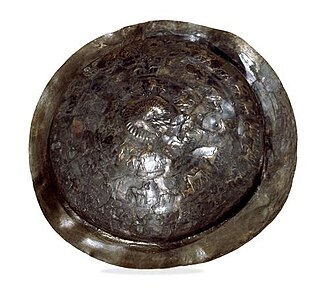
Erimena, according to tradition, was the twelfth king of Urartu and reigned from 625 to 605 BC. He was the successor of Sarduri III and father of Rusa III, who ruled Urartu from 610-590 B.C. Little is known about Erimena; his name was mentioned in an inscribed bronze shield found at Toprakkale by Hormuzd Rassam in 1880 that is now located in the British Museum. Erimena, according to a Babylonian chronicle, held an expedition in the mountainous region of Bit Hanounia, under the rule of Nabopolassar. He also suffered many attacks from the Babylonians which led to the decline of Urartu.
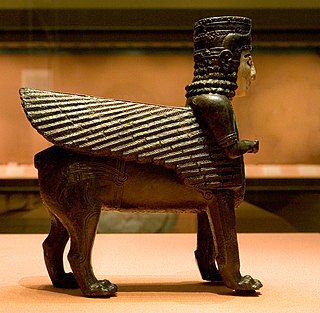
Urartu religion is a belief system adopted in the ancient state of Urartu, which existed from the 8th to 6th centuries BC. It was typical of despotic states from the Near East. The Urartu religion was polytheistic in nature and derived from the earlier beliefs of Mesopotamia and Anatolia. As in other beliefs of the ancient Near East, Urartu had a pantheon of deities, patronizing various phenomena. The main deity was Haldi. The worlds of humans and gods were united through ritual sacrifices. The Urartu religion absorbed the motifs of the tree of life, the serpent and the winged solar disk characteristic of the ancient Near East. Against the background of Mesopotamian beliefs, Urartu was distinguished by a high level of religious tolerance, which was conditioned by the multinationality of the state.
References
- ↑ Abaigail, P (6 May 2021). "The Mystery Behind the Ancient Underwater Kingdom in Turkey". Mobi Spirit. Retrieved 6 May 2021.
- Boris Piotrovskii, The Ancient Civilization of Urartu, London, 1969.
- Igor Diakonoff, The Pre-History of the Armenian People, Caravan Books, New York, 1988.
- M. Chahin, The Kingdom of Armenia, Curzon, London, 2001.